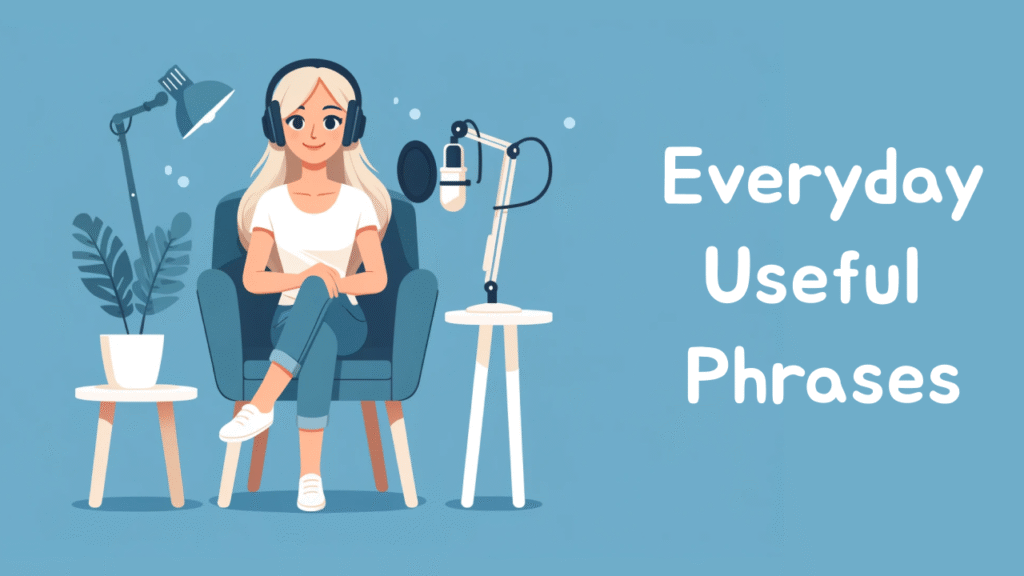Mastering Daily Routine Vocabulary with Sarah
In today’s episode of the Mr. English Channel podcast, Emily and Paul introduced us to a very practical topic: how to talk about your daily routine in English! This is an essential skill for every English learner because we often describe our daily habits when meeting new people, in speaking tests, or simply making conversation.
Why Learn Daily Routine Vocabulary?
Describing your day is one of the first things you’ll do in real conversations. Whether it’s at school, at work, or when traveling, these expressions come up all the time. Therefore, by learning simple sentences like “I get up at 6:00” or “I take the bus to work,” you’ll sound more natural and confident.
Sarah’s Daily Routine: A Great Example
In the podcast, we listened to Sarah explaining her day from morning to night. Here are some highlights from her routine:
- First, she gets up at 6:00, stretches, takes a shower, eats breakfast, and goes to work.
- Then, in the afternoon, she works until 5:00, eats lunch with her colleagues, and returns home.
- Finally, in the evening, she relaxes, cooks dinner, washes the dishes, and reads or watches TV before bed.
This routine is simple but full of useful vocabulary that you can easily apply to your own life.
Essential Phrases You Should Know
Let’s take a closer look at key phrases and their meanings, as explained by Emily and Paul:
| Phrase | Meaning | Example |
|---|---|---|
| Get up | To rise from bed. | I usually get up at 7:00. |
| Turn off my alarm | To stop the alarm from ringing. | She turns off her alarm quickly. |
| Stretch | To extend your body to relax your muscles. | I like to stretch after waking up. |
| Have a shower | To wash yourself under running water. | I have a shower every morning. |
| Get dressed | To put on clothes. | He gets dressed for work. |
| Make breakfast | To prepare the first meal of the day. | They make breakfast together. |
| Take the bus | To travel by bus. | We take the bus to school. |
| Work on my computer | To do tasks using a computer. | She works on her computer all morning. |
| Have lunch | To eat the midday meal. | I have lunch at 12:30. |
| Relax on the sofa | To rest on a couch. | I love relaxing on the sofa after work. |
| Go to bed | To lie down and sleep. | I usually go to bed at 10:00. |
Grammar Tip: Present Simple for Routines
One key takeaway is that Sarah used the present simple tense throughout her story. This tense is perfect for describing regular habits and routines. For instance:
- ✅ I wake up at 6:00.
- ✅ She takes the bus every day.
Remember to add -s for he/she/it forms!
In addition, if you want more grammar tips, check out our post: Present Simple vs. Present Continuous.
Practice Activity
Now it’s your turn! Try writing 3-5 sentences about your own daily routine using the vocabulary above. Here’s a quick example:
I wake up at 7:00. Then I brush my teeth and make coffee. After that, I take the train to work.
Feel free to share your sentences in the comments—we’d love to see your progress!
Final Thoughts
In conclusion, describing your daily routine is a must-know skill for English learners at all levels. Thanks to Sarah’s clear example and Emily and Paul’s helpful explanations, you now have the tools to talk confidently about your day. Keep practicing, and soon it will feel natural to express yourself in English!
Share this post with your friends who are also learning English and leave a comment telling us about your experiences and what other topics you would like to see on the blog! Happy learning!



O trabalho de vocês é incrível, nova inscrita. Obrigada pelo conteúdo e pelo os materiais. ❤️ Sucesso!
Encontrei seu canal no youtube e estou aprendendo bastante. Amando!!!!